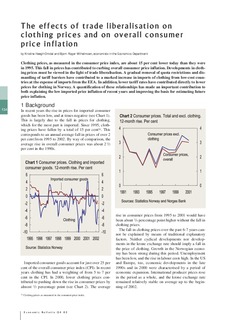| dc.contributor.author | Høegh-Omdal, Kristine | |
| dc.contributor.author | Wilhelmsen, Bjørn-Roger | |
| dc.date.accessioned | 2018-07-05T12:18:20Z | |
| dc.date.available | 2018-07-05T12:18:20Z | |
| dc.date.issued | 2002 | |
| dc.identifier.issn | 0029-1676 | |
| dc.identifier.uri | http://hdl.handle.net/11250/2504524 | |
| dc.description.abstract | Clothing prices, as measured in the consumer price index, are about 15 per cent lower today than they were in 1995. This fall in prices has contributed to curbing overall consumer price inflation. Developments in clothing prices must be viewed in the light of trade liberalisation. A gradual removal of quota restrictions and dismantling of tariff barriers have contributed to a marked increase in imports of clothing from low-cost countries at the expense of imports from the EEA. In addition, lower tariff rates have contributed directly to lower prices for clothing in Norway. A quantification of these relationships has made an important contribution to both explaining the low imported price inflation of recent years and improving the basis for estimating future price inflation. | nb_NO |
| dc.language.iso | eng | nb_NO |
| dc.publisher | Norges Bank | nb_NO |
| dc.rights | Attribution-NonCommercial-NoDerivatives 4.0 Internasjonal | * |
| dc.rights.uri | http://creativecommons.org/licenses/by-nc-nd/4.0/deed.no | * |
| dc.title | The Effects of Trade Liberalisation on Clothing Prices and on Overall Consumer Price Inflation | nb_NO |
| dc.type | Journal article | nb_NO |
| dc.subject.nsi | VDP::Samfunnsvitenskap: 200::Økonomi: 210::Samfunnsøkonomi: 212 | nb_NO |
| dc.source.pagenumber | 134-140 | nb_NO |
| dc.source.journal | Economic Bulletin | nb_NO |
| dc.source.issue | 4/2002 | nb_NO |

